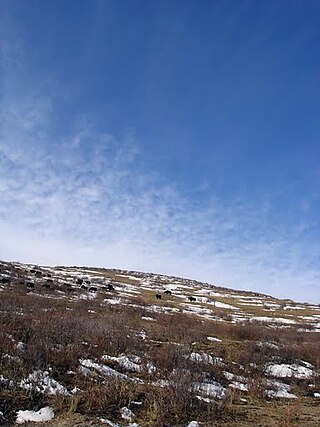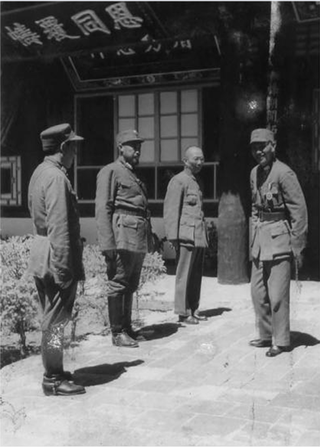
While the Tibetan plateau has been inhabited since pre-historic times, most of Tibet's history went unrecorded until the creation of Tibetan script in the 7th century. Tibetan texts refer to the kingdom of Zhangzhung as the precursor of later Tibetan kingdoms and the originators of the Bon religion. While mythical accounts of early rulers of the Yarlung dynasty exist, historical accounts begin with the introduction of Tibetan script from the unified Tibetan Empire in the 7th century. Following the dissolution of the empire and a period of fragmentation in the 9th-10th centuries, a Buddhist revival in the 10th–12th centuries saw the development of three of the four major schools of Tibetan Buddhism.

Amdo is one of the three traditional Tibetan regions, the others being Ü-Tsang in the west and Kham in the east. Amdo encompasses a large area from the Machu to the Drichu (Yangtze). It is mostly coterminous with China's present-day Qinghai province, but also includes small portions of Sichuan and Gansu provinces.

Kham is one of the three traditional Tibetan regions, the others being Domey also known as Amdo in the northeast, and Ü-Tsang in central Tibet. The official name of this Tibetan region/province is Dotoe. The original residents of Kham are called Khampas, and were governed locally by chieftains and monasteries. Kham covers a land area distributed in multiple province-level administrative divisions in present-day China, most of it in Tibet Autonomous Region and Sichuan, with smaller portions located within Qinghai and Yunnan.

The 7th Dalai Lama, Kelzang Gyatso, was recognized as the authentic 7th Dalai Lama of Tibet. He was seen as the true incarnation of the 6th Dalai Lama, and was enthroned after a pretender supported by the Koshut Khan was deposed.

Labrang Monastery is one of the six great monasteries of the Gelug school of Tibetan Buddhism. Its formal name is Genden Shédrup Dargyé Trashi Gyésu khyilwé Ling.
Surmang refers to a vast alpine nomadic and farming region, historically a duchy under the King of Nangchen, with vast land holdings spreading over what is today the Tibet Autonomous Region and Qinghai Province. In Tibetan the King of Nangchen's realm was called the "nyishu dza nga" or the 21 (provinces). Since 1959 it is mainly within the Yushu Tibetan Autonomous Prefecture of Qinghai province in China. Yushu Prefecture is 97% ethnic Tibetan. The Surmang region is one of the poorest regions in China ranking it among the world's highest infant and maternal mortality, almost 100% illiteracy, and personal income of less than US 14¢/day. It is part of the catchment in China of the 30 million ultra-poor.
Khams Tibetan is the Tibetic language used by the majority of the people in Kham. Khams is one of the three branches of the traditional classification of Tibetic languages. In terms of mutual intelligibility, Khams could communicate at a basic level with the Ü-Tsang branch.

GologTibetan Autonomous Prefecture is an autonomous prefecture occupying the southeastern corner of Qinghai province, China. The prefecture has an area of 76,312 km2 (29,464 sq mi) and its seat is located in Maqên County. Due to its special geographical location and natural environment, the entire autonomous preference has been included in the Chinese largest natural environmental protection area — the Sanjiangyuan National Park.

Mikyö Dorje was the eighth Karmapa, head of the Kagyu school of Tibetan Buddhism.

Andreas Gruschke was a German author, photographer and Tibet researcher. His scientific background was that of a geographer, Sinologist and ethnologist. He received a 1990 M.A. at Albert-Ludwigs-Universität Freiburg, and a Ph.D. in 2009 at Leipzig University.
This is a list of topics related to Tibet.

Kumbum Monastery, also called Ta'er Temple, is a Tibetan gompa in Lusar, Huangzhong County, Xining, Qinghai, China. It was founded in 1583 in a narrow valley close to the village of Lusar in the historical Tibetan region of Amdo. Its superior monastery is Drepung Monastery, immediately to the west of Lhasa. It is ranked in importance as second only to Lhasa.
Tibetan names typically consist of two juxtaposed elements.

Shambhala Training is a secular approach to meditation and a new religious movement developed by Tibetan Buddhist teacher Chögyam Trungpa Rinpoche and his students. It is based on what Trungpa calls Shambhala Vision, which sees enlightened society as not purely mythical, but as realizable by people of all faiths through practices of mindfulness/awareness, non-aggression, and sacred outlook.
Amdo Tibetan is the Tibetic language spoken in Amdo. It has two varieties, the farmer dialects and the nomad dialects.

Tibet was a de facto independent state in East Asia that lasted from the collapse of the Qing dynasty in 1912 until its annexation by the People's Republic of China in 1951.

Gadê County is a county in the southeast of Qinghai Province, China, bordering Gansu to the east. It is under the administration of Golog Tibetan Autonomous Prefecture.

The Ma clique fought a series of military campaigns between 1917 and 1949 against unconquered Amchok and Ngolok (Golok) tribal Tibetan areas of Qinghai (Amdo), undertaken by two Hui commanders, Gen. Ma Qi and Gen. Ma Bufang, on behalf of the Beiyang and Kuomintang governments of the Republic of China. The campaigns lasted between 1917 and 1949. The conflict was spurred by multiple factors, notably for economic and socio-political reasons rather than by any racial or religious enmity.
The Ninghai Army, later the 26th Division (National Revolutionary Army) was a Muslim Hui army of the Republic of China commanded by General Ma Qi, who controlled the Xining area of Qinghai, then a special region of Gansu province. It was founded by Ma Qi in 1915.
Golog Maqin Airport is an airport serving Golog Tibetan Autonomous Prefecture in southeastern Qinghai Province, China. It is located in Caozichang (草子厂) on the Dawutan Grassland (大武滩草原). Construction began on 14 September 2012 with an estimated total investment of 1.24 billion yuan, and the airport started operations on 1 July 2016. Golog is the fifth civil airport in Qinghai.















